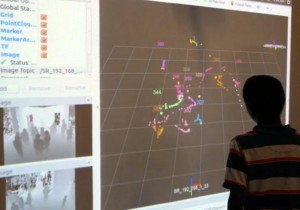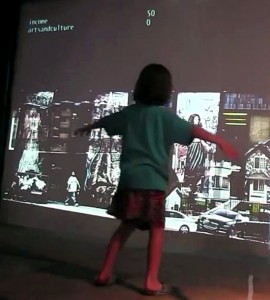OpenPTrack provides scalable, multi-camera person tracking,
enabling many people to be tracked over large areas in real time.
It is designed for applications in education, arts, and culture,
as a starting point for exploring group interaction with digital environments.
Compare it with other technologies.
Read our overview of how OpenPTrack works for more details.
Education: Creating engaging, embodied learning experiences
OpenPTrack empowers educators and transforms classrooms by making it easier to create embodied experiences for groups of learners. Real-time person tracking, along with pose recognition and object tracking, is a valuable building block for technology-enhanced learning, new paths of inquiry, and the development of problem-solving skills that take advantage of embodiment to engage groups in new ways.
Early adopters of OpenPTrack, the NSF-funded STEP, iSTEP and PLAE projects are investigating how embodied play among elementary school students can help them understand scientific phenomena. These programs, along with UCLA REMAP, are instrumenting elementary school classrooms with advanced tracking, in order to build upon the ways that young children engage in socio-dramatic play. They are asked to play roles in natural systems, and OpenPTack is used to record their interactions. Through this interactive role play, children explore and reflect upon the complex rules that govern our world.
To use OpenPTrack in your own educational projects, visit the Users page. To contribute to the OpenPTrack codebase, visit the Contributors page.


